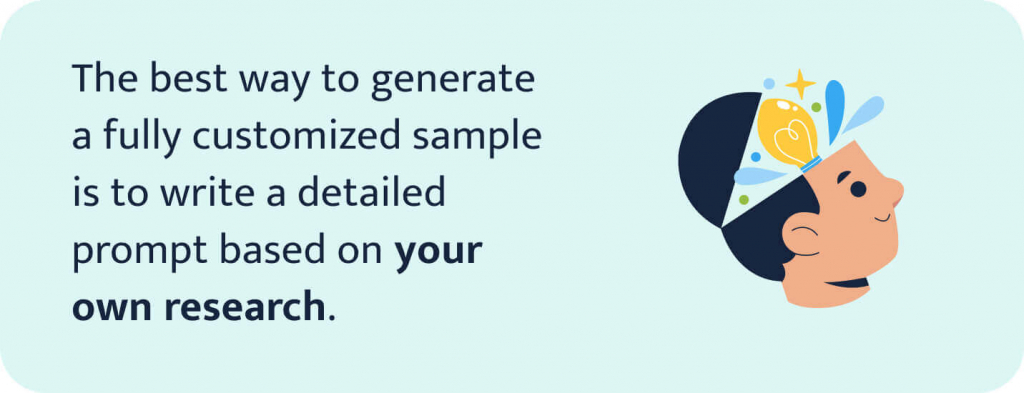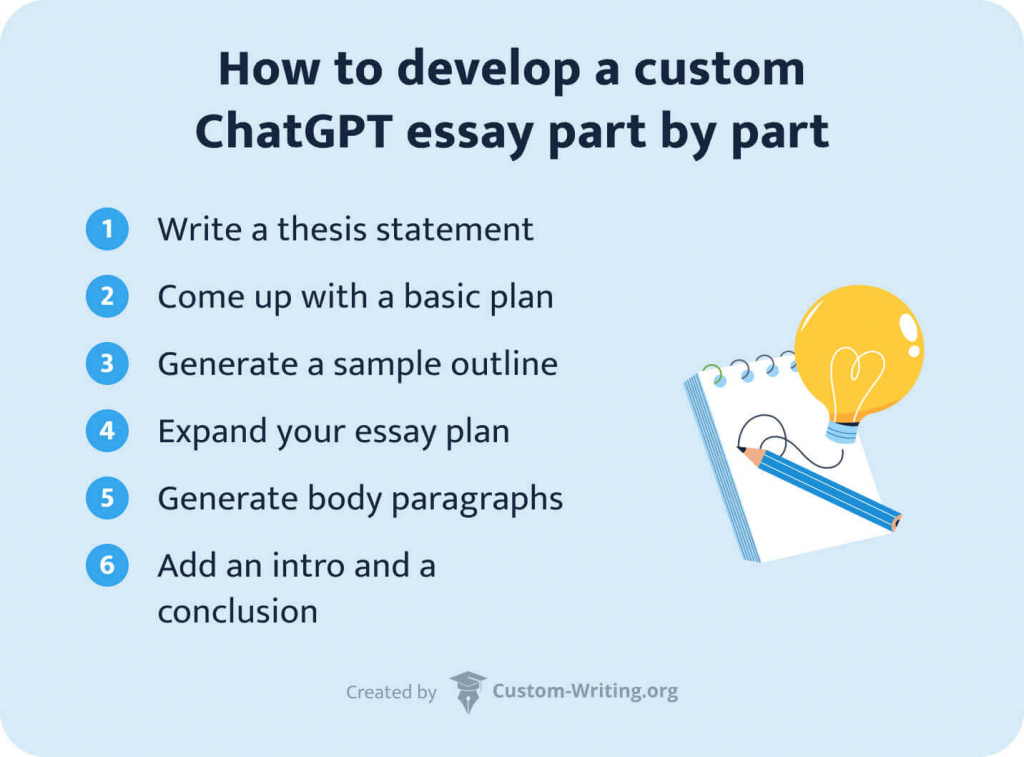Every student knows this awful feeling: you’re staring at the empty page, having no idea where to start and what to write about.
When it comes to essay writing, ideas don’t always come when you need them. But what if we told you there is a simple solution to this problem?
We’re talking about generating essay samples with the help of AI.
Want to know how to do it effectively? If so, keep reading! In this article, our Custom-Writing.org experts will share the most effective prompt template for generating model papers. We will also compare essays generated with good and bad prompts and tell you how to create a fully customized Chat GPT essay example part by part.
✍️ Is ChatGPT Good at Producing Essay Examples?
Generally, it is. ChatGPT is a powerful language model capable of creating fluent and well-structured texts on any topic. This includes academic essays of various kinds.

Generating papers via the chatbot has its benefits and drawbacks you need to keep in mind:
Benefits:
- It can write you a full-fledged essay of any length in mere seconds.
- It allows you to customize the results and request changes or explanations.
- The essays are usually well-structured and have no grammar mistakes.
- You will get tons of writing ideas from the resulting papers.
Drawbacks:
- ChatGPT’s replies often contain incorrect or made-up information.
- If you give it a poorly written prompt, you’ll get a generic essay that will be of no help.
- You never know where the chatbot takes its data from. It can also fabricate sources.
- It can refuse to generate essays on controversial topics. Additionally, it tends to give neutral and obvious replies when asked to take sides.
- ChatGPT’s replies to the same prompt are usually very similar in terms of content, wording, and structure.
- It also can’t write about the latest events because, as of January 2024, its database is limited to January 2022.
- The generated essays can only be used for inspiration. Submitting them or their parts as your own writing is strictly prohibited.
All in all, AI is capable of generating a decent essay sample. Still, you have to put some effort into getting the best possible responses from the chatbot and avoid associated ethical issues.
We will now explain how to generate high-quality sample texts using customized Chat GPT essay writing prompts.
But first, let’s conduct a little experiment and see whether a short and simple prompt will do the trick.
🤖 Generating a Chat GPT Essay Example with a Simple Prompt
If you’ve already tried using ChatGPT in your studies, you probably know that even the simplest prompt will likely yield decent results. But does it hold true regarding something as complex as essay writing?
Suppose we want to get a sample of a 5-paragraph essay that analyses the equal number of pros and cons of machine learning for business productivity. Besides, the sample has to include ways to minimize potential risks.
For our experiment, we’ve chosen the following topic: “How does machine learning affect business productivity?”
We will start with the simple prompt without any specifications. Let’s see if the chatbot guesses what we want based on the topic alone:
This Chat GPT essay example is not too bad. It has a logical structure and a strong thesis statement: “The impact of machine learning on business productivity is profound, influencing key areas such as automation, decision-making, and customer engagement.”
However, it has serious flaws:
- It’s focused on the benefits with no mention of the drawbacks.
- It doesn’t say anything about reducing potential threats.
- The essay’s main points are boring and predictable.
- There’s no guarantee that this essay is objective and based on facts.
- The sample is an informative essay rather than a pros and cons paper.
All these drawbacks mean we can’t use this essay as an example for our academic writing. But there is a way to get a better result – keep reading to learn about it.
💡 Pro tip:
If you’re short of time and need to generate a sample of academic text as quickly as possible, you can use our ChatGPT essay writer. This tool can create an excellent essay in a few clicks.
🔥 How to Prompt ChatGPT to Write an Essay: Detailed Approach
So, you already know that AI-generated essays are fluent and well-structured. Thanks to its massive datasets, ChatGPT is very powerful when it comes to creating texts. Even the free version can write any essay you want with all the necessary information. The premium version with GPT-4 is even more advanced and can access additional online resources.
But how can you make the program use its full potential to write a good essay that suits your needs?
The thing is to compose a detailed prompt.
You’ll be able to do it once you have a clear idea of what your paper will be about. Then, you can submit this information to the chatbot to get a top-notch sample.

To get the best possible result, you need to complete the following three steps:
- Research your topic. The point is to get the overall idea of what your essay can be about.
- Formulate a thesis statement based on your findings and conclusions.
- Create a basic essay plan. The more detail you add, the better.
Your prompt should include the essay’s topic, thesis statement, and main points from your outline. Here’s a handy template you may use:
Develop a #-word [essay type] essay on [your topic] using the following structure:
Introduction: start an introduction with a hook and end the paragraph with the thesis statement [your thesis statement]
Paragraph 1: write about [body paragraph’s main idea]. Mention [paragraph’s key points or examples]
Paragraph 2: write about [body paragraph’s main idea]. Mention [paragraph’s key points or examples]
Paragraph 3: write about [body paragraph’s main idea]. Mention [paragraph’s key points or examples]
Conclusion: develop a conclusion summarizing the main points from paragraphs 1-3.
Keep reading to see this prompt in action! But first, an important disclaimer:
Remember that any AI-generated text should be used for inspiration and reference purposes only. It’s important to resist the impulse to submit it as your own, no matter how good the essay may look. AI-generated text can be detected with almost 98% precision, and if you get caught, you will face serious consequences.
💡 Pro tip:
After ChatGPT writes you an essay, you need to re-read it to see if it includes everything you need. It would be easier to focus on details if someone else reads the text to you. We recommend using our essay reader for this purpose. It’s a handy online tool you can easily customize by choosing your preferred voice and speed.
📑 ChatGPT Essay Examples with Good & Bad Prompts
Now you know the secret behind the most effective prompts for generating samples! Feel free to use the template above to formulate your own prompts. And if you want to see real examples of ChatGPT essays generated with its help, go ahead and check them out below.
We tried generating different assignments using two methods. The first one involved a simple prompt with only the basic info. For the second method, we wrote detailed requests similar to what we’ve recommended in the previous section. Pay attention to the pros and cons of the resulting essays – they prove that a well-written prompt makes all the difference!
Key takeaways:
- Essays generated with a simple prompt lack depth and contain generic ideas. They also have no personal touch.
- Detailed prompts help generate more nuanced texts with relevant details and examples.
Chat GPT MBA Essay Examples with Simple & Detailed Prompts
MBA essays are notoriously hard to write. They require you to showcase your talents while adhering to strict guidelines. The resulting essay must be impressive enough to help you stand out among other candidates.
Luckily, Chat GPT is here, always ready to inspire you.
For our essay, we’ve chosen the topic, “Describe how you will contribute to our school community.” Let’s try it with the simple prompt first.
Key takeaways:
- The first sample’s biggest issue is the lack of concrete details. Instead, it uses vague descriptions (marked in bold.) It’s too impersonal and generic to serve as a model MBA sample.
- In contrast, the second essay features plenty of specifics, such as the author’s previous experience and potential contribution (marked in bold.) With a few improvements, you can turn this paper into a perfect MBA sample.
Let’s examine the essays in more detail.
MBA Essay Generated with a Simple Prompt
Strengths:
- It has a clear and logical structure.
- It effectively conveys the author’s intention to contribute to the school community.
Weaknesses:
- It needs more specific details and examples to corroborate the author’s claims.
- The author’s plans for fostering collaboration and inclusivity are too generic and don’t mention specific initiatives.
- It lacks insights into the author’s personal growth and development.
- The conclusion is rushed.
MBA Essay Generated with a Detailed Prompt
Strengths:
- The paper includes specific examples from the candidate’s professional experience.
- It mentions the precise steps the author plans to take to contribute to the school’s community.
- The essay clearly states the connection between the author’s skills and the MBA program’s goals and values.
- The paragraphs are well-structured with and focused.
Weaknesses:
- Adding some personal anecdotes could improve the essay.
- Sentence structures could’ve been more varied.
💡 Pro tip:
As you can see, with Chat GPT, college application essay writing can indeed become much easier. And if you need further assistance, you’re always free to use AI-based study tools. For example, you can create a much better hook with our attention grabber generator.
ChatGPT Scholarship Essay Examples
Do you need inspiration to write an impressive scholarship essay? ChatGPT can help you with this task as well. And if you work carefully on the prompt, your sample may even have a personal touch.
Let’s see what prompt will yield a more impressive scholarship essay.
Key takeaways
- The biggest problem with the first sample is the lack of detail. Instead of offering a personal perspective and describing lived experience in relation to the topic, it enumerates obvious solutions (marked in bold.) Overall, although the text is decent, we wouldn’t even call it a scholarship essay.
- Overall, it’s a much better example of a scholarship essay thanks to personal details such as the ones marked in bold. It produces a much better impression and can serve as a model scholarship essay.
Let’s take a closer look at these examples and evaluate them.
Scholarship Essay Generated with a Simple Prompt
Strengths:
- It has an attention-grabbing introduction.
- It demonstrates an understanding of the challenges posed by the issue in question.
Weaknesses:
- It lacks the personal perspective necessary for a scholarship essay.
- It’s too focused on the negative impact of technology on mental health.
- It uses excessively fancy wording such as “traverse the intricate landscape of modern life.”
- It needs specific real-life examples.
Scholarship Essay Generated with a Detailed Prompt
Strengths:
- It’s expressive and personal, just like a real scholarship essay.
- It convinces us that the author is passionate about their cause.
- The overall tone is positive, suggesting that the crisis can be addressed effectively with due attention and collaborative efforts.
- The conclusion is strong and gives a sense of closure.
Weaknesses:
- It could’ve been more creative with the structure – for instance, add a narrative segment describing a particular experience in detail.
- It’s also not entirely unique since it repeats some of the ideas from the first sample.
💡 Pro tip:
When writing your scholarship paper, you can take some ideas from the text generated by the chatbot and make them more personal and specific. For instance, you may add a quotation that fits the context and briefly explain its meaning. We recommend using our online quote explainer for this purpose. This simple but efficient tool can provide you with an accurate interpretation of any quotation within seconds.
ChatGPT Argumentative Essay Examples
Argumentative essays are among the most popular types of academic writing. Essentially, they study different sides of a problem and prove the claim stated in the thesis.

Suppose we need to generate an argumentative essay sample on “Should online learning be promoted?” Here’s what we’ve got with a simple prompt and with a detailed one.
Key takeaways:
- The first sample’s biggest weakness is its limited perspective. It focuses on technologies without mentioning online teaching methods and difficulties associated with them. It’s especially evident in this paragraph responding to the counterargument (marked in bold.)
- The second essay is much better than the first because it offers a more well-rounded perspective. In particular, it provides a much better response to the limitations of online learning (marked in bold.) Though this essay can benefit from some additional facts and statistics, it can already serve as a decent example.
Let’s evaluate the pros and cons of these essays.
Argumentative Essay Generated with a Simple Prompt
Strengths:
- It has a clear and logical structure.
- It features sensible examples and reasons proving the benefits of online learning.
Weaknesses:
- There’s a limited presentation of counterarguments.
- The essay gives a generic response to the opposing opinion.
- It lacks specific facts and citations.
Argumentative Essay Generated with a Detailed Prompt
Strengths:
- It’s a classic 5-paragraph argumentative essay where each part has a distinct focus.
- It has a well-formulated thesis statement.
- It draws a balanced picture by presenting both the benefits and drawbacks of online learning.
- The essay includes the response to counterarguments with practical strategies.
- It talks not only about technology but also about teaching methods.
Weaknesses:
- No statistical data or citations corroborate the points of this essay.
- It doesn’t mention context-specific solutions.
💡 Pro tip:
If you’re planning to use ChatGPT-generated content to stimulate your own writing, make sure to cite it as a source of inspiration. It will help you avoid possible cheating accusations.
🚀 Developing a Customized Chat GPT Essay Example Part by Part
As you can see, a detailed prompt can do wonders and help you create very decent essay samples. But what if you could make them even more customized? After all, even though our prompt allows you to decide on the sample’s main direction, the results remain mostly random. If you need to write a very lengthy paper with specific contents, an example like this may not be enough.
In that case, you can use another, even more effective approach – to generate each essay part separately. Then, you combine the elements and make a sample that suits all your needs.

This approach is more time-consuming than the previous one since you’ll have to conduct more thorough research and write detailed prompts for each essay part. Worry not – ChatGPT will help you speed up this process, and we will show you exactly how.
Keep reading to learn more about generating fully customized samples with the chatbot’s help!
Step 1: Write a Thesis Statement
To start formulating a prompt, you need to know your future essay’s main idea – the thesis statement. At this point, it doesn’t have to be well-formulated. Just make sure to express your point clearly.
To do it, you’ll need to research your chosen topic. It’s best to do it by yourself without using AI. This way, you’ll know where your argumentation comes from, and the resulting sample will convey your intended message.
Let’s see this process in action. We are going to generate a pros and cons essay on topic “How does machine learning affect business productivity?” step by step. Here is a thesis statement we’ve written for it:
Example:
While machine learning has manageable limitations, it has an overwhelmingly positive effect on business productivity, improving flexibility, efficiency, and costs.
💡 Pro tip:
When conducting your research, you’ll have to read numerous texts and search for the key information in them. To save time, you can use our main points generator. This groundbreaking tool can summarize critical ideas of any text instantly.
Step 2: Come Up with a Basic Essay Plan
Now, it’s time to create a custom outline. It doesn’t necessarily mean writing a super detailed draft. Instead, it’s enough to come up with the basic plan.
You can do it in four simple steps:
- Analyze your thesis statement.
- Think of the number of body paragraphs you will need to explain the thesis fully.
- Specify the main idea for each paragraph.
- Add 2-3 points of focus per paragraph based on your research.
Again, we recommend you write an outline without using AI:
- You’ll ensure the sample is structured the way you want.
- Doing additional research will help you to find the most recent information ChatGPT knows nothing about.
- You can include controversial points and ideas AI will likely avoid.
Here is the basic outline we’ve developed for our essay:
Example:
- Introduction.
- Thesis. While machine learning has manageable limitations, it has an overwhelmingly positive effect on business productivity, improving flexibility, efficiency, and costs.
- Body paragraph 1. The positive influence of Artificial Intelligence: enhanced flexibility, increased efficiency, cost reduction.
- Body paragraph 2. Drawbacks of machine learning in a business environment: biased algorithms, security risks, lack of necessary skills.
- Body paragraph 3. Possible mitigation strategies: treating AI outputs as drafts, safeguarding data privacy, providing employee training.
- Conclusion.
💡 Pro tip:
Consider taking notes while looking for information. They will come in handy later when you start writing your own essay. With our textbook-to-notes converter, you’ll easily create informative notes in bullet point format.
Step 3: Use ChatGPT to Improve an Outline
Right now, your outline is just a bare-bones version. It’s time to look for further ideas to make it more detailed. And AI will help you with that.
Make sure to turn to ChatGPT only after you’ve developed the basic outline yourself. This way, you’ll get a much better sample with arguments you can be sure of.
You can now generate a detailed sample plan for your paper and use its best parts to expand your basic outline. Specify the topic, thesis, and main points of each paragraph in your prompt, and the chatbot will do the rest.
Here’s a template you may use:
Example:
Write an outline for an #-paragraph [essay type] essay on the topic [your topic]. The main idea is: [your thesis]. Focus on [what the body paragraphs are about] and acknowledge [what else the body paragraphs are about]. Keep the outline focused and concise within the specified structure.
We recommend you use all the elements of our prompt to avoid unpredictable results and overcome AI’s limitations. For instance, if you omit the phrase “Keep the outline focused and concise within the specified structure,” ChatGPT may provide you with 6-7 paragraphs instead of 5.
Now, let’s fill in this template with our information:
The generated essay plan was very comprehensive and contained everything we asked for. For example, it offered a detailed overview of the drawbacks.
💡 Pro tips:
- If you want your paper to include a paragraph with case studies, feel free to mention it in your prompt. It will be even better if you analyze them yourself beforehand. Our case study answers finder is here to help you with this task.
- Another way to generate a customized essay plan is to use our outline maker. The best part? It doesn’t require formulating a prompt!
Step 4: Expand Your Outline
Now, you can pick the most compelling ideas from your generated outline and add them to the basic essay plan you wrote yourself.
At this step, try to be as creative as you can. Instead of copying everything ChatGPT has generated, it’s best to choose specific aspects that you like best. You can also rearrange them however you want until you get the desired result. For example, if an idea from one paragraph suits another paragraph much better, don’t hesitate to move it there.
Here’s the outline we’ve compiled using this method:
Example:
Introduction:
- Definition of machine learning
- Growing significance of machine learning in business
Thesis: While machine learning has manageable limitations, it has an overwhelmingly positive effect on business productivity, improving flexibility, efficiency, and costs.
Body paragraph 1: Positive influence of Artificial Intelligence
- Automation of repetitive tasks, speeding up decision-making processes
- Adaptive algorithms for dynamic business environments
- Optimization of resource allocation
Body paragraph 2: Drawbacks of machine learning in a business environment
- High upfront investment for machine learning integration
- Biased algorithms, security risks, and privacy issues related to data collection
- Challenges in comprehending machine-driven decision-making and training expenses for employees
Body paragraph 3: Possible mitigation strategies:
- Treating AI outputs as drafts, implementing transparent algorithms, and complying with data protection regulations
- Providing tools for understanding machine-driven decisions and investing in employee training gradually
Conclusion:
- Recap of the main points
- Emphasis on the overall positive impact of machine learning on business productivity
- Recognition of limitations and the importance of ongoing efforts to mitigate challenges.
As you can see, we effectively expanded our basic outline:
- It now contains a detailed description of the introduction and conclusion.
- The plan generated by ChatGPT also gave us some valuable suggestions to add to our first body paragraph.
- We liked the idea of initial implementation costs and added it to the drawbacks.
- As for the algorithm bias and security risks, we’ve merged it into one point and called it “ethical issues.”
- The main points in the third body paragraph remain intact but are extended with subpoints from the generated outline.
Step 5: Generate Essay Examples for Every Body Paragraph
Now that you have a detailed outline, you are ready to prompt ChatGPT with it to generate an entire paper. But first, we want to tell you about a much better way of developing fully-customized essay examples.
The point of this method is to ask the chatbot to write several examples of each body paragraph. Then, you combine the best parts, add some transition phrases (our transition phrase generator will help you with that,) and get a perfectly customized text.
This method has several advantages:
- Have more ideas to choose from.
- Have control over the sample’s contents.
Learn more about the topic. - Put together very long samples.
Now, let’s see how to do it. You need to start a new chat and type in a prompt with the main points and subpoints of the paragraph.
The resulting prompt can look like this:
Write 2 variants of a 190-word body paragraph for the essay on the topic “How does machine learning affect business productivity?” following the plan:
Body paragraph 1 – Positive influence of Artificial Intelligence:
Enhanced flexibility:
- Automation of repetitive tasks
- Speeding up decision-making processes
Increased efficiency:
- Adaptive algorithms for dynamic business environments
Cost reduction:
- Optimization of resource allocation.
Before adding this example to our custom sample’s first body paragraph, we looked it up to see whether it was true. This is something you’ll have to do with all the facts ChatGPT and its alternatives offer you since they can be made up.
The very first search result proved that this fact is indeed true. Additionally, it provided us with specific examples of algorithms that suggest products based on a user’s purchases. This is something we can also add to our future essay.
You can do the same for each body paragraph. This way, you’ll have plenty of material to work with. Simply pick the most interesting segments from the generated examples, fact-check them, and combine them to form your customized paragraphs.
Step 6: Create an Introduction and a Conclusion
Finally, your custom sample needs an introduction and conclusion. To create them, do the following:
- Start a new chat.
- Enter the body paragraphs into the dialog field and add “Write an introduction for all of the above.”
- Click “Send message.”
- Once you get the results, type “Write a conclusion for all of the above.”
These prompts may seem very simple, but trust us – they work better than any other option. The chatbot will summarize all the samples and formulate an opening and concluding passage for everything at once.
Here’s what we’ve got for our essay:
Now, all you need to do is combine everything into your tailor-made sample. You may even decide to reformulate your previous thesis statement if your sample introduction inspires you. And if you don’t like the opening paragraph created by ChatGPT, you can make another one with our introduction writer.
🎁 Bonus Tips for Improving ChatGPT Essay Samples
Congratulations! You now have a customized essay sample. But how about making it even better in terms of style and grammar? After all, AI writing is often monotonous and clichéd, which makes it hard to read. Besides, the text you’ve put together may appear fragmented and need some adjustments.
Here’s how you can improve the content of your sample:
- Watch out for context drift. AI tends to go off-topic, especially in longer texts. To make your paper flow well, try to remove all the fluff and leave only the most relevant information within each section.
- Ensure coherence and consistency. Re-read the sample and restructure all segments that appear disjointed. Make sure everything is logically connected.
- Avoid repetitiveness. ChatGPT is notorious for using the same phrases and grammatical structures over and over again. This includes non-finite -ing clauses, sentences with “from… to…,” and enumerations of exactly three items. Varying sentence lengths and structures will improve your sample essay’s rhythm and flow.
- Correct the word usage. AI loves flowery language and often uses fancy words to make its outputs more impressive. Unfortunately, it often ignores the context of these words and generates results that sound unnatural. For example, symbols can be “navigating the themes” of a literary work, and boundaries can be “exploring the interconnectedness” of phenomena. If you stumble upon a phrase that sounds strange to you, try replacing it with a more straightforward option from a thesaurus.
- Check for grammar mistakes. The chatbot is very good at grammar but can still fail at things like subject-verb agreement and pronoun use, especially with the names of people it doesn’t know about.
- Replace the passive voice. ChatGPT’s formal writing relies on it, which makes the resulting texts hard to follow. Changing the passive voice to active will make the generated content more readable.
💡 Pro tip:
To ensure that the final text you’re submitting doesn’t resemble AI-generated content, we recommend checking it with a ChatGPT detector tool. For example, our free AI checker is great at spotting chatbot-written text.
✅ Key Takeaways
As you can see, ChatGPT is capable of creating excellent examples of any essay type. The more detailed your prompt is, the better the results will be.
To compose an effective prompt and ensure ethical AI use, you need to do some work by yourself:
- Research the topic,
- Make your own conclusions,
- Develop a thesis statement,
- Decide on the body paragraphs’ main points,
- Include this information in your prompts.
If you go through all these steps, you will get a custom sample that will inspire an ethically written essay that reflects your own views and findings.
Feel free to use our advice and templates to use AI to your benefit and generate fully customized ChatGPT essay examples. Did our tips help you get better responses from the chatbot? Let us know in the comments!
Check out other excellent materials about ChatGPT and similar AI tools:
- Can I Get Caught Using ChatGPT?
- Using ChatGPT for Homework
- 17 Best AI Tools for Students in 2026
- How to Use ChatGPT to Make a PowerPoint Presentation
- Can Chat GPT Proofread and Edit an Essay?
- 17 Best AI Tools for Homework in 2026
🔗 References
- How to Use ChatGPT to Write Essays That Impress: Beebom
- How to Use Chat GPT to Write an Essay Complete Guide: Geeky Gadgets
- Back to School? How ChatGPT Can Help You with Your Essay Writing: ZDNet
- Should I Use ChatGPT to Write My Essays?: Harvard Summer School
- Here’s How Forbes Got the ChatGPT AI to Write 2 College Essays in 20 Minutes: Forbes
- How to Write ChatGPT Prompts: Your 2026 Guide: Coursera
- How to Write ChatGPT Prompts to Get the Best Results: Search Engine Journal
- Guide: How to Use ChatGPT to Improve Your Writing: ExpressVPN
- ChatGPT Can Write Your Essays, but Should You Use It?: Android Authority
- Ethical Use of AI in Writing Assignments: KU Center for Teaching Excellence
- AI Could Be Great for College Essays: Slate
- Can You Use ChatGPT for Your College Essay?: PrepScholar
- Is it OK to use AI on your school assignments?: Microsoft
- 4 Ways That AI Can Help Students: The Conversation
- Can ChatGPT Write Essays?: Rock Content
- Write an Essay with ChatGPT: gHacks Technology News



